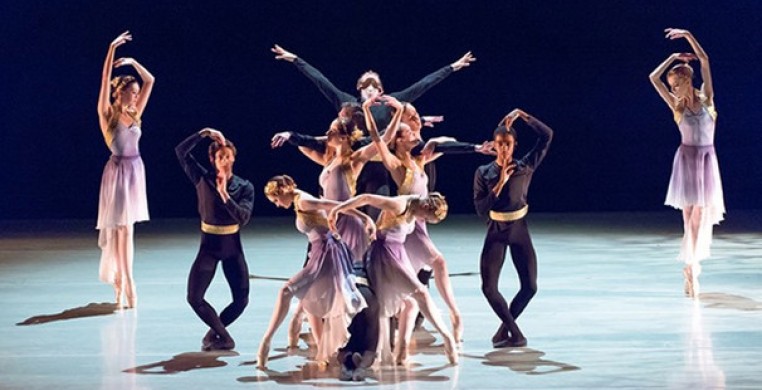A quietly understated miracle has been taking place every day for the past seven years in a not-so-quiet corner of 17 N. State Street, under the exacting eyes of Ballet Chicago Artistic Director Daniel Duell and his wife, Associate Artistic Director Patricia Blair. (The company, established in 1987, moved to its current location in 2009.)
Harris Theater audiences got a glimpse of that miracle last Saturday in “Take Flight,” this year’s one-day-only spring season, performed by an impressive ensemble of young men and women poised to launch professional careers.
While Chicago boasts many superb ballet schools and professional training programs, and three high-caliber pre-professional studio companies, Ballet Chicago is the only midwest school and company singularly dedicated to sustaining and developing upon the artistic legacy of New York City Ballet founding director, George Balanchine, which includes anointed permission from The Balanchine Trust to perform select ballets from the master’s opus. And it has the credentials to do it. Duell was a principle dancer for NYC Ballet from 1972-87, under Balanchine’s direction, and Ms. Blair was a ballerina in the Eglevsky Ballet, under the direction of former NYC Ballet principal Edward Villella.
This year, Ballet Chicago took on the audacious challenge of Mr. B’s musically demanding “Square Dance” (1958), a romp for seven couples inspired by American square dance forms and set to the music of Vivaldi and Corelli. Equally challenging, Balanchine’s “Stars and Stripes Pas de Deux” (1958) provided tour de force fun and technical fireworks in a patriotic salute to the music of John Philip Sousa. Complimenting the Balanchine works were resident choreographer and Ballet Chicago alum, Ted Seymour’s “Celestial Rites” (2013), and the world premiere of his “Secrets de Printemps,” created for Ballet Chicago.
One of the great pleasures of watching this accomplished young company perform, and there were many, was the heightened sense of musicality throughout the program. It was especially impressive in “Square Dance,” in which the complex rhythms, melodic lines, canons, and instrumentation of the baroque music are mirrored in the complexity of Balanchine’s choreography and spatial patterns. Balanchine seems to have adorned the detail and ornate busyness of the music with equally busy entrechats, echapés- battus, and multiple relevés in quick succession, all at breathtaking velocity. The clarity of articulation is certainly a technical achievement, especially when, to create its desired effect, the choreography demands exacting clarity of opposition in contrasting ensemble patterns, a hallmark of Balanchine. But above and beyond their technical mastery, these dancers really came alive and moved, giving the audience an authentic taste of Balanchine's mastery and innovation, a rare treat for Chicago.
Duell describes the “Stars and Stripes Pas de Deux” as a “classic, cheeky grand pas de deux, humorous, boisterous and athletic,” and so it was, danced with bold flair by Elizabeth Chlanda and Ethan Mazak. All the bells and whistles of virtuoso technique were confidently sounded as this charming couple demonstrated sparkling enthusiasm for each other and tackled the demands of the choreography with infectious joie de vivre. Mazak had fun playing the “El Capitain” character, which let him show off his wonderful elevation and double saut de basques. Chlanda was a coquettish “Liberty Belle,” tossing off sky-high extensions and the requisite fouetté turns with real flair. These dancers are poised to take off. Watch for them!
Ted Seymour used Tchaikovsky’s little-known epic mass, “Hymn of the Cherubim,” for “Celestial Rites,” what he calls his “science fiction fantasy” ballet for sixteen dancers. Most striking are the complex rhythm and scene shifts that evolve into arresting sculptural configurations. The dancers seem right at home in Seymour's neoclassic modernity. His creative use of the Tchaikovsky mass effectively transported us into an other-worldly realm whose inhabitants engage in enobling endeavors. Admittedly inspired by Balanchine's genius for painting a moving canvas of human bodies, Seymour's deft use of ensemble opposition framed compelling solo dancing by Molly Brown and Dana Coons.
Ballet Chicago's studio company was joined by accomplished students of all ages from the Ballet Chicago School for Seymour’s “Secrets de Printemps,” dedicated to the memory of ballerina Violette Verdi. Choreographed to Maurice Ravel’s lush “Le Tombeau de Couperin,” this engaging lyrical piece uses large group movement for an expansive design that captures the breathy first stirrings of springtime. Group movement fairly blooms as these dancers sweep the music across the stage. The dancers, even the tiniest ones, show uncanny sensitivity to each other and to the music, precision ensemble work, and phrasing that speaks to their training as expressive artists, not just technicians. Their impeccably clean technical execution was complimented by an organic sense of breath and suspension.
It was a delight to behold such a blossoming of ballet's next generation in a program that embodied the artistic integrity that clearly underlies the superb training and artistic values instilled at Ballet Chicago. Truly a breath of fresh air!

